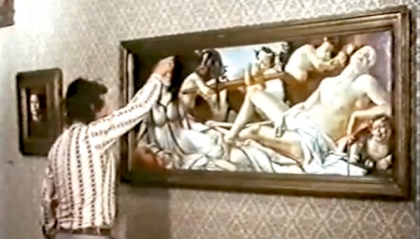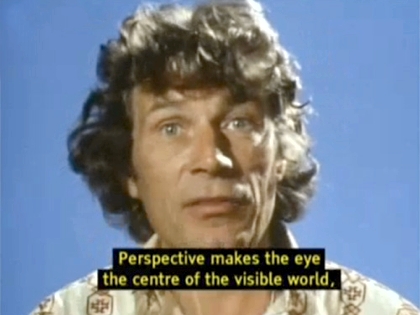Out of the archive
Image lib: John Berger’s Ways of Seeing

Forty years ago John Berger’s BBC2 series challenged us to be wiser consumers of fine art. As BFI Southbank marks the anniversary, Jonathan Conlin asks if the series speaks to us today
A man walks into a gallery and cuts the head out of a 15th-century painting with a Stanley knife. From the opening sequence, it was clear that Ways of Seeing was going to be a rather different kind of art documentary from Kenneth Clark’s Civilisation, which had aired on BBC2 three years before. Although the attack was staged in a studio mock-up of the National Gallery, it was clear that Berger and his director Mike Dibb were serious about liberating art from the “false religiosity” that surrounded it inside art museums, between the covers of art books and on the small screen.
Though less overtly violent, the series’ edits, cutaways and rostrum-camera gymnastics were so many illustrations of a process that had begun some time before, with the invention of photography. Photography, film, advertising, the colour supplement and now television had replaced the unique work of art with an infinitely reproducible image. Berger’s aim was to show what we had lost, and what we had gained.
Originally commissioned to serve the vanity of this or that prince or duke, the work of art now served many masters. Unfortunately for a Marxist like Berger, they were the wrong ones: multinational firms trying to persuade us that we can live the princely life if we consume their products. Though his tousled hair and piercing stare lent him a powerful presence on camera, here Berger let the camera do the talking for him, in a series of sequences seamlessly juxtaposing Old Masters and contemporary advertising to demonstrate their shared emphasis on exclusivity, hierarchy and male potency.
In one sequence Dibb gives us a passenger’s-eye view of a ride up a London tube escalator. We move past framed ads for lipstick… lingerie… and almost miss the reproduction of Correggio’s The School of Love (c. 1525) slipped in. Dibb similarly adds a ‘Trespassers Keep Out’ sign onto the tree behind Gainsborough’s Mr and Mrs Andrews (1750), revealing the land behind them to be a possession denied to us, the viewer, rather than a charming celebration of a shared vision of the English landscape.
The series constantly reminds us that the precious original is absent, or, in the case of the consumerist dream sequences in Episode 3, forever put off. Berger teases us by reminding us of the conventions established by previous art documentaries – the zooming in on details, or the laying over of music to suggest mood, for example – and then subverting them. At times the effect is giddyingly disorientating. Berger shows Francisco Goya’s harrowing execution scene The Shootings of the Third of May, then cuts to totally unrelated clips from other channels, including a performance of Middle of the Road’s ‘Tweedle Dee Tweedle Dum’ on Top of the Pops. Our perception of the work changes. Context, it would seem, is all.

Berger is not suggesting that works of art have all been reduced to trivial images by the lens. Granted, Ways of Seeing is a virtuoso display of televisual effects, presented by a virtuoso frontman of the model we now call the “presenter as hero”. In this regard it is surprisingly similar to Civilisation, the BBC’s stunning first foray into colour arts documentary and on-location filming. But where Civilisation’s Michael Gill and Peter Montagnon hide the mechanics of their art, Berger and Dibb insist we acknowledge their artifice, for that is the main point. It is now our job to switch off the numbing consumerist opiate and exit the cave. Once free, we can, Berger promises, use images “as a language, we can talk with them”, and so connect them with our own emotions and experiences.
Programmes about the visual arts have been broadcast on television for more than 70 years. Back in 1937, when Kenneth Clark lectured on Italian Renaissance art from the BBC’s studios at Alexandra Palace, London, he could only be viewed by the five thousand London households who then had sets. By the 1960s television was a mass medium, and documentaries on the history of art reached millions. All of us have become familiar with a certain set of conventions observed in such programmes; we can recognise different styles of presenter. Yet we know next to nothing about how those conventions and styles developed, partly because art historians have refused to discuss them, partly because so few directors of such documentaries (apart from Ken Russell) went on to have film careers.
Television’s short memory isn’t just a problem for historians. It dooms all of us to watching (or rather, not watching) less promising formats that are reinvented again and again, while other modes of art documentary languish forgotten in the archive. Ways of Seeing represents one such format – the “television argument”, as John Wyver has dubbed it. Matt Collings’s work aside, we rarely get to see it. Instead we drown in programmes that focus on artists (always “rebels” or “revolutionaries”) rather than the art. Beauty is forgotten. All art is political. At first glance Berger may seem responsible for this shift. Looking back now, it is clear that he was not.
Looking back – and forward – will be all the easier now that BFI Southbank is launching a recurring strand of programming devoted to the visual arts on the small screen. ‘Broadcasting the Arts’ kicks off this April with a special John Berger season. Stretching from his early films for Granada and BBC’s Monitor in the 1950s up to his 1980s work on photography, this season will include a showing of all four episodes of Ways of Seeing followed by an on-stage interview with series director Mike Dibb and Tim Marlow. Stanley knives optional.
‘Ways of Seeing: John Berger on the Small Screen’ runs 3–17 April at BFI Southbank, London; ‘Ways of Seeing’ is on 4 April. Jonathan Conlin is the author of the BFI TV Classic ‘Civilisation’ (Palgrave Macmillan)
See also
Over Your Cities Grass Will Grow reviewed by Lisa Mullen (November 2010)
Critics on critics: 21 writers on the writing that inspires them (October 2008)
Pollock reviewed by Michael Bracewell (June 2002)
High Art reviewed by Leslie Felperin (April 1999)
